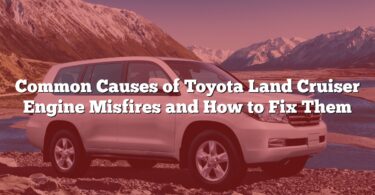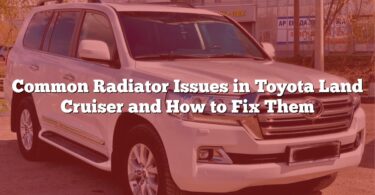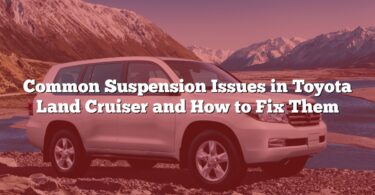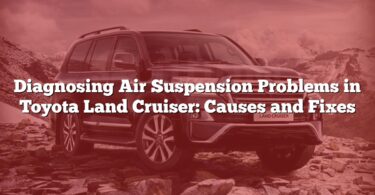A soft brake pedal can be alarming and potentially dangerous, especially in a vehicle as reliable as the Toyota Land Cruiser. This guide dives into the most common causes of a soft brake pedal, from air in the brake system to faulty components, and provides clear, actionable solutions to address each issue. Whether you’re troubleshooting or looking to prevent future problems, this comprehensive resource will help ensure your Land Cruiser’s braking system stays dependable and safe.
Diagnosing and Fixing 39 Problems with 39 Solutions for a Soft Brake Pedal:
| N° | Problem/Cause | Solution |
|---|---|---|
| 1 | Air in the brake system | Bleed the brakes thoroughly to remove trapped air. |
| 2 | Brake fluid leak | Locate and repair leaks; refill and bleed the system. |
| 3 | Worn brake pads | Replace worn brake pads with new ones. |
| 4 | Faulty master cylinder | Replace or rebuild the master cylinder. |
| 5 | Contaminated brake fluid | Flush the brake system and refill with fresh fluid. |
| 6 | Boiling brake fluid due to overheating | Allow brakes to cool and replace overheated fluid. |
| 7 | Faulty brake booster | Test the booster; repair or replace if defective. |
| 8 | Damaged or worn brake lines | Replace damaged brake lines. |
| 9 | Loose or damaged brake calipers | Tighten or replace calipers as needed. |
| 10 | Faulty ABS system or actuator | Diagnose ABS; repair or replace the actuator if necessary. |
| 11 | Defective wheel cylinder | Replace the defective wheel cylinder. |
| 12 | Improper brake fluid level | Adjust brake fluid to the correct level. |
| 13 | Overheated brakes | Inspect for damage; allow to cool and adjust driving habits. |
| 14 | Internal leak in the braking system | Replace leaking components and re-seal as necessary. |
| 15 | Faulty brake proportioning valve (e.g., LSPV issues) | Repair or replace the brake proportioning valve. |
| 16 | Corroded or damaged brake fittings | Clean or replace corroded or damaged fittings. |
| 17 | Faulty vacuum pump (diesel models) | Inspect and replace the vacuum pump if defective. |
| 18 | Worn or damaged seals in the braking system | Replace all worn or damaged seals. |
| 19 | Excessive moisture in the brake fluid | Flush and replace with fresh, dry brake fluid. |
| 20 | Incorrect or incomplete brake bleeding procedure | Follow manufacturer’s recommended bleeding procedure. |
| 21 | Brake hose expansion under pressure | Replace worn or degraded brake hoses. |
| 22 | Misaligned or improperly installed brake components | Inspect and realign or reinstall components correctly. |
| 23 | Faulty brake pressure sensor | Replace the faulty pressure sensor. |
| 24 | Internal damage to brake caliper pistons | Rebuild or replace the calipers. |
| 25 | Insufficient vacuum supply to the brake booster | Check vacuum supply; repair leaks or replace faulty components. |
| 26 | Faulty brake pedal linkage | Inspect and repair or replace damaged linkage. |
| 27 | Damaged or malfunctioning brake hardware (e.g., springs, clips) | Replace faulty hardware with new parts. |
| 28 | Improper adjustment of the parking brake mechanism | Adjust the parking brake mechanism according to specifications. |
| 29 | Failure of the brake reservoir cap or vent | Replace the reservoir cap or vent if defective. |
| 30 | Incorrectly sized master cylinder bore | Replace the master cylinder with the correct size for the system. |
| 31 | Booster pushrod pin gap misalignment | Adjust the booster pushrod pin gap to the recommended specifications. |
| 32 | Mechanical interference with brake components | Identify and modify or reposition interfering components. |
| 33 | Mixed or incompatible brake fluid types (e.g., DOT 3/4 with DOT 5) | Flush the system completely and refill with compatible fluid. |
| 34 | Rust or debris contamination in brake fluid | Flush the system to remove debris and refill with clean fluid. |
| 35 | Swollen or degraded brake hoses | Replace all affected brake hoses. |
| 36 | Air trapped in ABS unit requiring activation during bleeding | Use proper ABS bleeding procedures or tools to remove trapped air. |
| 37 | Faulty or worn shims behind brake pads | Replace shims and ensure proper installation. |
| 38 | Internal bore imperfections causing leaks in calipers or master cylinder | Replace or re-machine the defective components. |
| 39 | Corrosion on caliper piston shims or hardware | Clean or replace corroded parts and lubricate as needed. |
Detailed Guide: Toyota Land Cruiser Brake Pedal Issues: Problems and Solutions:
1. Air in the Brake System
- Reason 1: Air can get trapped in the brake lines during maintenance or due to a loose fitting.
- Reason 2: Improper bleeding after replacing components can leave air pockets in the system.
Solution:
Bleed the brakes to remove air.
Steps:
- Use a brake bleeder or pressure bleeding system.
- Start bleeding at the wheel furthest from the master cylinder (usually rear-right).
- Move to the next wheel (rear-left, front-right, front-left).
- Check for firm pedal feel before finishing.
2. Brake Fluid Leak
- Reason 1: Corroded or damaged brake lines can leak fluid.
- Reason 2: Faulty fittings or seals may cause leaks.
Solution:
Inspect all lines, calipers, and fittings for leaks.
Steps:
- Check the brake fluid reservoir for low levels.
- Identify the leak source by inspecting brake lines and calipers.
- Replace the damaged component.
- Refill and bleed the brake system.
3. Worn Brake Pads
- Reason 1: Excessively worn brake pads increase the distance the caliper pistons must travel, causing a soft pedal.
Solution:
Replace brake pads.
Steps:
- Inspect pad thickness. Replace if below recommended minimum.
- Use high-quality pads to ensure optimal performance.
4. Faulty Master Cylinder
- Reason 1: Internal seals in the master cylinder can fail, leading to pressure loss.
Solution:
Rebuild or replace the master cylinder.
Steps:
- Remove the master cylinder from the brake booster.
- Replace seals or install a new unit.
- Reinstall and bleed the system.
5. Contaminated Brake Fluid
- Reason 1: Moisture in the brake fluid reduces its boiling point.
- Reason 2: Mixing incompatible brake fluid types causes system issues.
Solution:
Flush and replace the brake fluid.
Steps:
- Drain the old fluid from all wheels.
- Refill with the correct type of brake fluid.
- Bleed the system to ensure clean fluid throughout.
6. Boiling Brake Fluid Due to Overheating
- Reason 1: Prolonged braking generates heat, causing the fluid to boil and create air bubbles.
Solution:
Allow brakes to cool. Replace overheated fluid if necessary.
7. Faulty Brake Booster
- Reason 1: Loss of vacuum pressure reduces braking assistance.
Solution:
Replace the brake booster.
Steps:
- Check the vacuum supply hose for leaks.
- Remove and replace the faulty booster.
- Test the brakes for proper assist functionality.
8. Damaged or Worn Brake Lines
- Reason 1: Worn or cracked lines may allow fluid loss or air entry.
Solution:
Replace damaged brake lines.
Steps:
- Inspect all brake lines for wear.
- Install new lines.
- Bleed the brake system.
9. Loose or Damaged Brake Calipers
- Reason 1: Calipers that are loose or misaligned compromise braking efficiency.
Solution:
Tighten or replace calipers.
Steps:
- Inspect caliper bolts and brackets.
- Tighten bolts to manufacturer specifications.
- Replace if damaged.
10. Faulty ABS System or Actuator
- Reason 1: Air or malfunction in the ABS actuator can disrupt pressure balance.
Solution:
Activate and bleed the ABS system using a scan tool.
11. Defective Wheel Cylinder
- Reason 1: Leakage from wheel cylinders in drum brakes can cause pressure loss.
Solution:
Replace the defective wheel cylinder.
12. Improper Brake Fluid Level
- Reason 1: Low fluid reduces hydraulic pressure.
Solution:
Refill to the proper level and inspect for leaks.
13. Overheated Brakes
- Reason 1: Frequent braking causes excessive heat, reducing effectiveness.
Solution:
Let the brakes cool and inspect for damage. Replace any affected components.
14. Internal Leak in the Braking System
- Reason 1: Faulty seals in calipers, wheel cylinders, or master cylinder cause pressure loss.
Solution:
Repair or replace the leaking components.
15. Faulty Brake Proportioning Valve (e.g., LSPV Issues)
- Reason 1: Improper adjustment or malfunction affects pressure distribution.
Solution:
Replace or adjust the proportioning valve.
16. Corroded or Damaged Brake Fittings
- Reason 1: Corroded fittings compromise the seal and pressure.
Solution:
Replace or clean corroded fittings.
17. Faulty Vacuum Pump (Diesel Models)
- Reason 1: The pump may fail to provide sufficient vacuum.
Solution:
Inspect and replace the vacuum pump.
18. Worn or Damaged Seals in the Braking System
- Reason 1: Seals in calipers, wheel cylinders, or the master cylinder can degrade over time, causing leaks or pressure loss.
Solution:
Replace all worn or damaged seals.
Steps:
- Disassemble the affected component (caliper, master cylinder, or wheel cylinder).
- Replace the damaged seals with new, OEM-quality seals.
- Reassemble and test for leaks.
19. Excessive Moisture in the Brake Fluid
- Reason 1: Brake fluid absorbs moisture over time, reducing its effectiveness and boiling point.
Solution:
Flush the brake system and replace with fresh, dry brake fluid.
Steps:
- Completely drain the old fluid.
- Use a vacuum or pressure bleeder to flush moisture out.
- Refill with high-quality DOT-recommended brake fluid.
20. Incorrect or Incomplete Brake Bleeding Procedure
- Reason 1: Improper bleeding leaves air pockets in the system, leading to a soft pedal.
Solution:
Bleed the brakes using the correct sequence.
Steps:
- Follow the manufacturer-recommended order (usually rear-right, rear-left, front-right, front-left).
- Use a pressure or vacuum bleeder for consistency.
- Ensure all bleeder screws are properly tightened.
21. Brake Hose Expansion Under Pressure
- Reason 1: Old or weak rubber hoses may expand, reducing hydraulic pressure to the calipers.
Solution:
Replace old rubber brake hoses with reinforced or braided steel hoses.
22. Misaligned or Improperly Installed Brake Components
- Reason 1: Misaligned calipers, pads, or other hardware can reduce braking efficiency.
Solution:
Realign or reinstall the components.
Steps:
- Inspect caliper and pad alignment.
- Correct any misalignment or reinstall the components according to specifications.
23. Faulty Brake Pressure Sensor
- Reason 1: The sensor may fail to correctly measure or relay hydraulic pressure.
Solution:
Replace the faulty sensor.
Steps:
- Locate the sensor on the brake line or master cylinder.
- Remove the defective unit and install a new one.
- Test the system for proper pressure readings.
24. Internal Damage to Brake Caliper Pistons
- Reason 1: Rust or physical damage can prevent the pistons from operating smoothly.
Solution:
Rebuild or replace the damaged calipers.
Steps:
- Remove the caliper and inspect the pistons.
- Replace damaged pistons or seals.
- Reinstall and bleed the brakes.
25. Insufficient Vacuum Supply to the Brake Booster
- Reason 1: A vacuum leak reduces the booster’s effectiveness, leading to a hard or soft pedal.
Solution:
Inspect and repair the vacuum source.
Steps:
- Check the vacuum hose for leaks or disconnection.
- Replace or repair the hose.
- Test the booster with a vacuum gauge.
26. Faulty Brake Pedal Linkage
- Reason 1: A worn or damaged linkage may cause insufficient pedal travel or response.
Solution:
Inspect and repair or replace the linkage.
Steps:
- Check for excessive play or misalignment in the pedal assembly.
- Replace worn bushings or adjust the linkage as needed.
27. Damaged or Malfunctioning Brake Hardware
- Reason 1: Springs, clips, or other hardware may fail, affecting brake function.
Solution:
Replace the damaged hardware.
Steps:
- Inspect all hardware components.
- Install new springs, clips, or retainers.
- Test for proper braking function.
28. Improper Adjustment of the Parking Brake Mechanism
- Reason 1: A misadjusted parking brake can interfere with normal braking.
Solution:
Adjust the parking brake mechanism.
Steps:
- Locate the parking brake adjuster near the drum or cable assembly.
- Adjust the tension to manufacturer specifications.
- Test both the parking and regular brake systems.
29. Failure of the Brake Reservoir Cap or Vent
- Reason 1: A malfunctioning cap or vent may lead to improper fluid pressure.
Solution:
Replace the reservoir cap or repair the vent.
Steps:
- Inspect the cap for cracks or blockage.
- Replace it if damaged.
- Ensure proper venting before testing the brakes.
30. Incorrectly Sized Master Cylinder Bore
- Reason 1: An improperly sized bore results in insufficient pressure or excessive pedal travel.
Solution:
Install the correct master cylinder for your brake system.
31. Booster Pushrod Pin Gap Misalignment
- Reason 1: An incorrect gap between the booster pushrod and master cylinder reduces braking efficiency.
Solution:
Adjust the booster pushrod gap.
Steps:
- Remove the master cylinder to access the pushrod.
- Measure the gap using a feeler gauge.
- Adjust the pushrod length to the recommended specification.
32. Mechanical Interference with Brake Components
- Reason 1: A misaligned caliper or component contacting the frame or suspension can cause soft brakes.
Solution:
Identify and resolve the interference.
Steps:
- Inspect for contact points during full steering lock or suspension travel.
- Adjust or replace interfering components.
33. Mixed or Incompatible Brake Fluid Types
- Reason 1: Using incompatible fluids (e.g., DOT 3/4 with DOT 5) can cause gelling or corrosion.
Solution:
Flush the system completely and replace with the correct fluid type.
34. Rust or Debris Contamination in Brake Fluid
- Reason 1: Contaminants reduce fluid efficiency and may clog lines.
Solution:
Clean the system and replace the fluid.
Steps:
- Drain and clean the reservoir.
- Flush all brake lines and components.
- Refill with fresh fluid.
35. Swollen or Degraded Brake Hoses
- Reason 1: Aged hoses may swell or leak, reducing pressure.
Solution:
Replace all degraded hoses.
36. Air Trapped in ABS Unit Requiring Activation During Bleeding
- Reason 1: Air may remain trapped in the ABS module, requiring activation to release.
Solution:
Activate the ABS using a scan tool during bleeding.
37. Faulty or Worn Shims Behind Brake Pads
- Reason 1: Damaged or missing shims reduce braking force.
Solution:
Replace or reinstall shims properly.
38. Internal Bore Imperfections Causing Leaks
- Reason 1: Imperfections in caliper or master cylinder bores may cause leaks.
Solution:
Replace or rebuild the affected component.
39. Corrosion on Caliper Piston Shims or Hardware
- Reason 1: Corrosion affects the smooth operation of caliper pistons.
Solution:
Clean or replace corroded components.
Steps:
- Remove the caliper and disassemble it.
- Clean or replace the piston and hardware.
- Reinstall and test for proper operation.
Preventing Future Issues:
To keep your Toyota Land Cruiser’s braking system in optimal condition and avoid soft brake pedal issues in the future, follow these proactive maintenance steps:
- Regularly Inspect Brake Components
- Check brake pads, calipers, and rotors for wear or damage every 10,000 miles or during routine service.
- Inspect brake lines and hoses for cracks, corrosion, or swelling.
- Replace Brake Fluid Periodically
- Flush and replace brake fluid every 2 years or as recommended by the manufacturer.
- Use the correct brake fluid type (DOT 3, DOT 4, or as specified) to prevent contamination or incompatibility.
- Perform Proper Bleeding After Maintenance
- Bleed the brake system thoroughly after replacing any brake components to eliminate air pockets.
- Use a pressure bleeder or vacuum system for efficient and complete air removal.
- Check and Adjust the Brake Booster and Master Cylinder
- Ensure the booster pushrod pin gap is correctly aligned after any brake system repair.
- Test the master cylinder for leaks or pressure inconsistencies periodically.
- Inspect the ABS System
- Run diagnostic tests on the ABS system during regular servicing.
- Ensure the ABS unit is functioning and properly bled to avoid trapped air.
- Replace Aging Brake Hoses and Fittings
- Replace rubber hoses with braided steel hoses to reduce expansion under pressure.
- Inspect and replace corroded fittings as needed.
- Avoid Overheating Brakes
- Use engine braking when driving downhill to minimize brake system strain.
- Allow brakes to cool during heavy or prolonged braking to prevent fluid boiling.
- Store the Vehicle Properly
- Avoid long-term exposure to moisture or corrosive conditions that can damage brake components.
- If storing for extended periods, move the vehicle occasionally to prevent caliper or rotor seizing.
- Use Quality Parts and Fluids
- Always use OEM or high-quality aftermarket brake components.
- Avoid mixing brake fluid types and ensure all replacement parts match the system specifications.
- Schedule Regular Professional Inspections
- Have a certified technician inspect the brake system at least once a year.
- Address any issues promptly to prevent further damage or failures.
By following these steps, you can enhance the reliability and lifespan of your Land Cruiser’s brake system while ensuring a safe driving experience.







